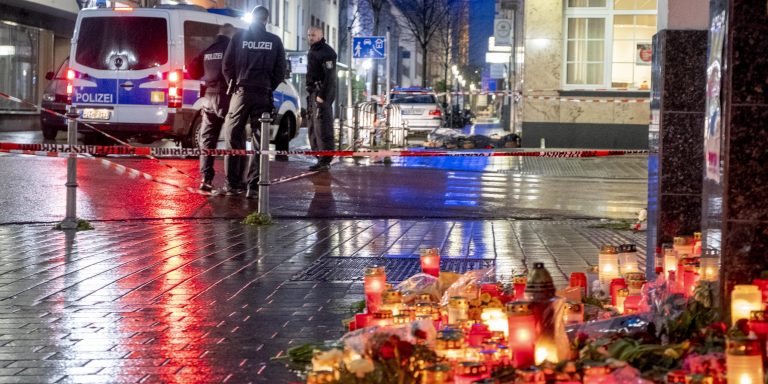INTELBRIEF
February 24, 2020
IntelBrief: Far-Right Extremists and White Supremacists Grow More Emboldened

- The terrorist attack in Hanau, Germany last week underscores a broader trend of white supremacists, neo-Nazis and other extremists operating with increasing impunity both in the United States and in Europe.
- The far-right continues to mobilize in Europe, with organized marches planned in Budapest, Hungary and Sofia, Bulgaria, attended by neo-Nazis from Germany, Sweden, Poland, the United States and elsewhere.
- Anti-Semitism, Islamophobia and anti-immigrant sentiments are on the rise, converging in a toxic mixture fueled by hatred, extremism, and misogyny.
- A global network of white supremacist extremists extends from North America to Europe and Australia, with strong roots in Scandinavia and Eastern Europe.
.
The far-right attack in Hanau, Germany last week underscores a broader trend of white supremacists, neo-Nazis, and other extremists operating with increasing impunity both in the United States and in Europe. And even as government authorities, law enforcement agencies, and security services are dedicating more resources and manpower to counter this rising threat, more still needs to be done. In mid-February, German authorities arrested a dozen individuals who were part of a far-right cell that was plotting attacks against mosques, asylum seekers, and pro-refugee politicians. Attacking politicians is a favored tactic of the far-right in Europe, intended to intimidate the population and spread fear and hysteria. Thomas Mair, a sympathizer of the British far-right group National Action, murdered Member of Parliament Jo Cox in June 2016. For its part, National Action has attempted to recruit individuals to fight alongside white supremacists in Ukraine. German pro-refugee politician Walter Lubcke was assassinated by a neo-Nazi in June 2019.
Hundreds of Neo-Nazis from all over Europe flocked to Budapest, Hungary in early February to take part in march commemorating Adolf Hitler and Nazi Germany, referring to the Nazis and their collaborators as ‘heroes.’ In Sofia, Bulgaria, the so-called ‘Lukov March,’ held annually since 2003 in honor of pro-Nazi Bulgarian General Hristo Lukov, was blocked by the courts from taking place. Still, that did not prevent neo-Nazis and white supremacists from gathering in Sofia, including individuals from Sweden, Poland, Germany, and the United States. Anti-Semitism, Islamophobia, and anti-immigrant sentiments are on the rise, converging in a toxic mixture fueled by hatred, extremism, and misogyny. Both Germany and France have experienced high-profile anti-Semitic events over the past year, while The Netherlands recently announced that the number of anti-Semitic incidents in that country reached the highest at any point over the last three decades.
Meanwhile in the United States, there have already been several high-profile marches and protests organized by white supremacist extremists and their supporters in 2020. More than one hundred protesters belonging to the Patriot Front, a white nationalist splinter group from Vanguard America, gathered in Washington D.C. The group’s members, most of whom wore masks, marched on the National Mall while chanting slogans like ‘Reclaim America.’ In January, several members of The Base were arrested as they were planning acts of violence in the lead up to a pro-gun rally held in Richmond, VA. These events dovetail with recent reports of a surge in white supremacy propaganda—including stickers, posters, banners, and fliers—blanketing college campuses and universities throughout the United States over the past year. A report by the Anti-Defamation League (ADL) noted more than 2,700 such incidents in 2019, double the amount from the year prior. In mid-February, in a sign of how rampant the ideology of white supremacy has become in the United States, the Department of Justice sentenced 64 white supremacists to a combined 820 years in federal prison. Although this was the nation’s largest prosecution of white supremacist groups and their affiliates, it represents merely a snapshot of white supremacy and Aryan Brotherhood activity in one state—Texas. The state of New Jersey raised its threat level for white supremacists to ‘high,’ which ranks it as more severe than the current threat level for both al-Qaeda and the Islamic State.
The organized events in Europe are reflective of a broader trend that has emerged—the increasing globalization of white supremacist extremism and its multiple variants and offshoots. Members from the Rise Above Movement (R.A.M.) and the Nordic Resistance Movement were present at the Lukov event in Sofia, Bulgaria. Groups like The Base and Atomwaffen Division are also becoming more emboldened, seeking to grow their organizations transnationally and recruit members from a range of different countries. This global network of white supremacist extremists extends from North America to Europe and Australia. Ukraine has been an epicenter of training and organizing for the movement, which also claims strong roots in Scandinavia and Eastern Europe. Still, in the United States,no white supremacist organizations have been designated as foreign terrorist organizations, which means that law enforcement has fewer resources at its disposal to combat these groups. The United States urgently needs to move in the direction of conducting a rigorous and accurate assessment of the challenge posed by transnational violent white supremacist extremists. This includes passing legislation that gives authorities the tools necessary to counter these organizations before the threat further metastasizes.
.
For tailored research and analysis, please contact: info@thesoufancenter.org